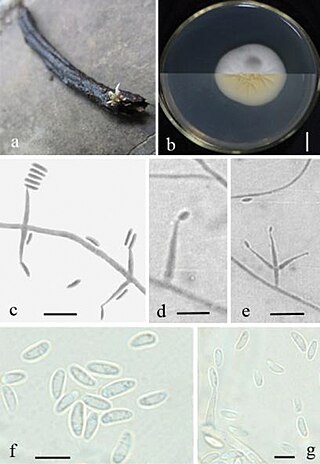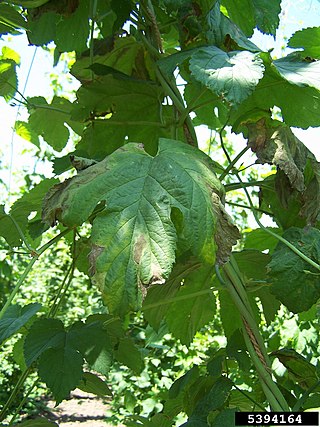
Cryptococcus is a genus of fungi in the family Cryptococcaceae that includes both yeasts and filamentous species. The filamentous, sexual forms or teleomorphs were formerly classified in the genus Filobasidiella, while Cryptococcus was reserved for the yeasts. Most yeast species formerly referred to Cryptococcus have now been placed in different genera. The name Cryptococcus comes from the Greek for "hidden sphere". Some Cryptococcus species cause a disease called cryptococcosis.

Commonly known as hellebores, the Eurasian genus Helleborus consists of approximately 20 species of herbaceous or evergreen perennial flowering plants in the family Ranunculaceae, within which it gave its name to the tribe of Helleboreae. Despite names such as "winter rose", "Christmas rose" and "Lenten rose", hellebores are not closely related to the rose family (Rosaceae). Many hellebore species are poisonous.

Beauveria bassiana is a fungus that grows naturally in soils throughout the world and acts as a parasite on various arthropod species, causing white muscardine disease; it thus belongs to the group of entomopathogenic fungi. It is used as a biological insecticide to control a number of pests, including termites, thrips, whiteflies, aphids and various beetles. Its use in the control of bedbugs and malaria-transmitting mosquitos is under investigation.

Verticillium is a genus of fungi in the division Ascomycota, and are an anamorphic form of the family Plectosphaerellaceae. The genus used to include diverse groups comprising saprobes and parasites of higher plants, insects, nematodes, mollusc eggs, and other fungi, thus the genus used to have a wide-ranging group of taxa characterised by simple but ill-defined characters. The genus, currently thought to contain 51 species, may be broadly divided into three ecologically based groups - mycopathogens, entomopathogens, and plant pathogens and related saprotrophs. However, the genus has undergone recent revision into which most entomopathogenic and mycopathogenic isolates fall into a new group called Lecanicillium.

Metarhizium robertsii – formerly known as M. anisopliae, and even earlier as Entomophthora anisopliae (basionym) – is a fungus that grows naturally in soils throughout the world and causes disease in various insects by acting as a parasitoid. Ilya I. Mechnikov named it after the insect species from which it was originally isolated – the beetle Anisoplia austriaca. It is a mitosporic fungus with asexual reproduction, which was formerly classified in the form class Hyphomycetes of the phylum Deuteromycota.

The American Elm cultivar Ulmus americana 'Valley Forge' was raised by the Agricultural Research Service in Maryland. The tree was released to wholesale nurseries without patent restrictions by the U. S. National Arboretum in 1995 after proving to have a high resistance to Dutch elm disease. 'Valley Forge' proved only moderately successful in the US National Elm Trial, averaging a survival rate of 66.7% overall, owing largely to environmental factors rather than susceptibility to disease.
Verticillium longisporum, also known as Verticillium Wilt, is a fungal plant pathogen that commonly infects canola. V. longisporum can attack other brassica plants as well as woody ornamentals. A main symptom of the infected plant is wilting. In America, V. longsiporum primarily effects eudicot plants. This pathogen can be very devastating and hard to eradicate, responding only to expensive fumigation or fungal resistant plants.

Metarhizium acridum is the new name given to a group of fungal isolates that are known to be virulent and specific to the Acrididea (grasshoppers). Previously, this species has had variety status in Metarhizium anisopliae ; before that, reference had been made to M. flavoviride or Metarhizium sp. describing an "apparently homologous and distinctive group" of isolates that were most virulent against Schistocerca gregaria in early screening bioassays.

Lecanicillium lecanii is now an approved name of an entomopathogenic fungus species, that was previously widely known as Verticillium lecanii (Zimmerman) Viegas), but is now understood to be an anamorphic form in the Cordyceps group of genera in the Clavicipitaceae. Isolates formerly classified as V. lecanii could be L. attenuatum, L. lecanii, L. longisporum, L. muscarium or L. nodulosum. For example, several recent papers, such as Kouvelis et al. who carried out mitochondrial DNA studies, refer to the name L. muscarium.

Lecanicillium is a genus of fungi in the order Hypocreales and is described as anamorphic Cordycipitaceae; 21 species are currently described. Some of these entomopathogenic fungus species were previously widely known as Verticillium lecanii (Zimmerman) Viegas. This genus was first named and introduced by Rasoul Zare (IRIPP) and Walter Gams (CBS).

Coccus viridis is a soft scale insect in the family Coccidae with a wide host range. It is commonly known as green scale or sometimes coffee green scale because it is a major pest of coffee crops throughout the world.

Purpureocillium lilacinum is a species of filamentous fungus in the family Ophiocordycipitaceae. It has been isolated from a wide range of habitats, including cultivated and uncultivated soils, forests, grassland, deserts, estuarine sediments and sewage sludge, and insects. It has also been found in nematode eggs, and occasionally from females of root-knot and cyst nematodes. In addition, it has frequently been detected in the rhizosphere of many crops. The species can grow at a wide range of temperatures – from 8 to 38 °C for a few isolates, with optimal growth in the range 26 to 30 °C. It also has a wide pH tolerance and can grow on a variety of substrates. P. lilacinum has shown promising results for use as a biocontrol agent to control the growth of destructive root-knot nematodes.
Lecanicillium muscarium is the approved name of an entomopathogenic fungus species, that was previously widely known as Verticillium lecanii (Zimmerman) Viegas), but is now understood to be an anamorphic form in the Cordyceps group of genera in the Cordycipitaceae. It now appears that isolates formerly classified as V. lecanii could be L. attenuatum, L. lecanii, L. longisporum, L. muscarium or L. nodulosum. For example, several recent papers, such as Kouvelis et al. carried out mitochondrial DNA studies, refer to this name.

Hugh David Loxdale is an entomologist. He was professor of ecology at the Institute of Ecology, University of Jena from 2009 to 2010, president of the Royal Entomological Society from 2004 to 2006, and honorary visiting professor at the School of Biosciences, Cardiff University. Loxdale works on the population biology, ecology, and genetics of insects, especially aphids and their wasp parasitoids.

Pandora is a genus of fungi within the order Entomophthorales of the Zygomycota. This has been supported by molecular phylogenetic analysis.

Verticillium dry bubble, recently named Lecanicillium fungicola, is a mycoparasite that attacks white button mushrooms, among other hosts, during its generative period. L. fungicola infects the casing layer on the cap structure of several edible mushrooms. This fungal pathogen does not typically infect wild mushrooms, but more commonly cultivated mushrooms are infected such as A. bisporus, which are typically grown in large quantities. Severity of disease depends on several factors, including timing of infection and environmental conditions. Dry bubble follows the typical verticillium life cycle, although insect vectors play a large role in the spread of this disease. Control for L. fungicola is limited, and strict measures must be taken to prevent the spread of infection. L. fungicola is a devastating pathogen in the mushroom industry and causes significant losses in the commercial production of its main host A. bisporus. Annual costs for mushroom growers are estimated at 2–4% of total revenue.

Rhopalosiphum rufiabdominale, the rice root aphid or red rice root aphid, is a sap-sucking insect pest with a wide host range and a global distribution. As a member of the superfamily Aphidoidea, it is one of 16 species of the genus Rhopalosiphum. Adults and nymphs are soft-bodied and usually dark green with brown, red, or yellow tones. Like all aphids, reproduction is sexual and asexual, depending on the environmental conditions and host plant. Rice root aphids cause injury to external plant parts, namely the roots or stem, by feeding on plant sap and vector several important plant viruses. The hosts of this pest extend across multiple plant families with most belonging to Rosaceae, Poaceae, and Solanaceae. R. rufiabdominale is universally associated with Prunus species but also infests various field crops, greenhouse vegetables, cannabis, and other ornamental plants. While this aphid originates from east Asia, it spans nearly every continent. Dispersal is particularly widespread across the United States, India, and Australia, with crop damage documented in multiple instances, although economic losses are primarily associated with Japanese rice crops. Nonetheless, it remains a pest of serious concern due to its high mobility, discrete habitat, and adaptive plasticity, giving it the rightful reputation as a successful invader.

Verticillium nonalfalfae is a soilborne fungus in the order Hypocreales. It causes verticillium wilt in some plant species, particularly Ailanthus altissima. The fungus produces a resting mycelium characterized by brown-pigmented hyphae. It is most closely related to V. dahliae and V. alfalfae.
Verticillium alfalfae is a fungus. It causes verticillium wilt in some plant species, particularly alfalfa. It produces yellow-pigmented hyphae and microsclerotia, while producing resting mycelium. It is most closely related to V. albo-atrum and V. nonalfalfae.
Verticillium klebahnii is a fungus often pathogenically inhabiting lettuce. It causes verticillium wilt in some plant species. It produces yellow-pigmented hyphae and microsclerotia, while producing abundant chlamydospores and resting mycelium. It is most closely related to V. tricorpus and V. isaacii.















